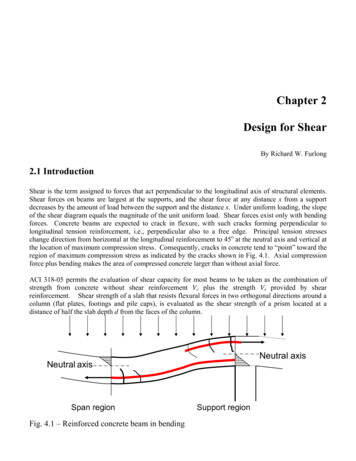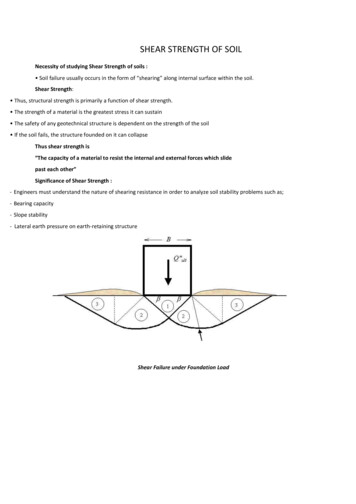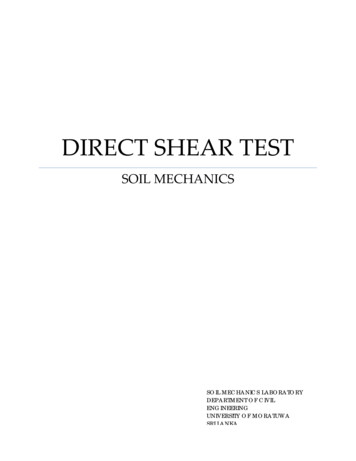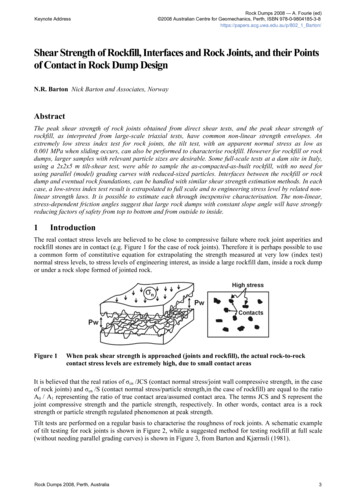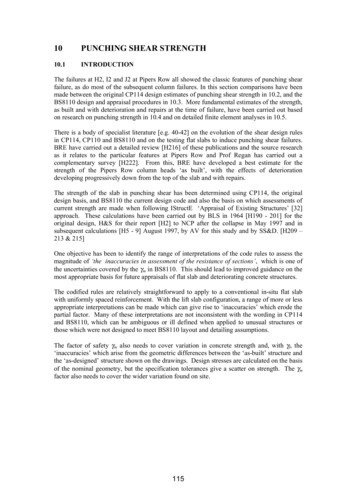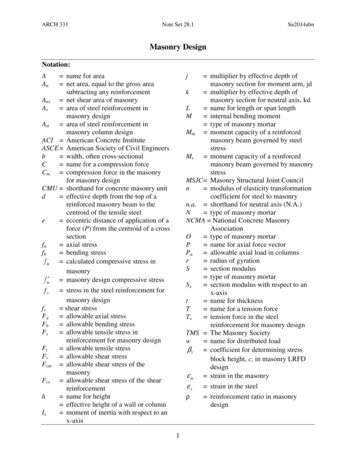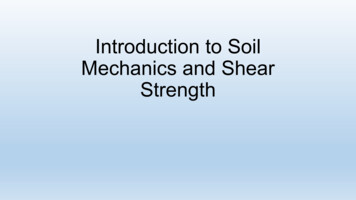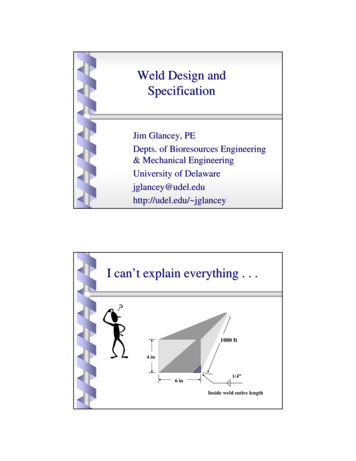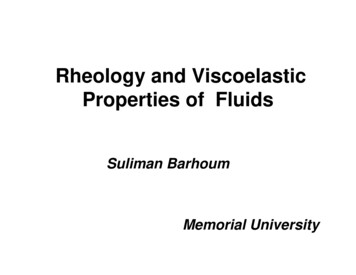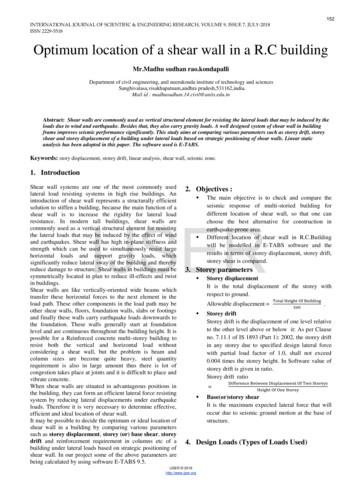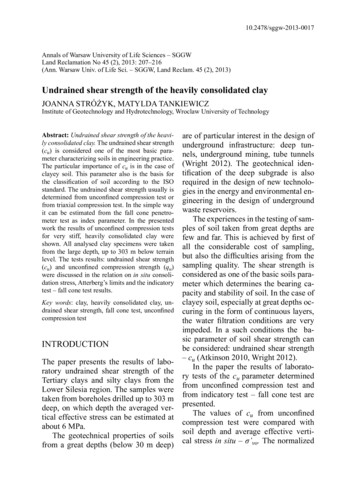
Transcription
10.2478/sggw-2013-0017Annals of Warsaw University of Life Sciences – SGGWLand Reclamation No 45 (2), 2013: 207–216(Ann. Warsaw Univ. of Life Sci. – SGGW, Land Reclam. 45 (2), 2013)Undrained shear strength of the heavily consolidated clayJOANNA STRÓŻYK, MATYLDA TANKIEWICZInstitute of Geotechnology and Hydrotechnology, Wroclaw University of TechnologyAbstract: Undrained shear strength of the heavily consolidated clay. The undrained shear strength(cu) is considered one of the most basic parameter characterizing soils in engineering practice.The particular importance of cu is in the case ofclayey soil. This parameter also is the basis forthe classification of soil according to the ISOstandard. The undrained shear strength usually isdetermined from unconfined compression test orfrom triaxial compression test. In the simple wayit can be estimated from the fall cone penetrometer test as index parameter. In the presentedwork the results of unconfined compression testsfor very stiff, heavily consolidated clay wereshown. All analysed clay specimens were takenfrom the large depth, up to 303 m below terrainlevel. The tests results: undrained shear strength(cu) and unconfined compression strength (qu)were discussed in the relation on in situ consolidation stress, Atterberg’s limits and the indicatorytest – fall cone test results.Key words: clay, heavily consolidated clay, undrained shear strength, fall cone test, unconfinedcompression testINTRODUCTIONThe paper presents the results of laboratory undrained shear strength of theTertiary clays and silty clays from theLower Silesia region. The samples weretaken from boreholes drilled up to 303 mdeep, on which depth the averaged vertical effective stress can be estimated atabout 6 MPa.The geotechnical properties of soilsfrom a great depths (below 30 m deep)are of particular interest in the design ofunderground infrastructure: deep tunnels, underground mining, tube tunnels(Wright 2012). The geotechnical identification of the deep subgrade is alsorequired in the design of new technologies in the energy and environmental engineering in the design of undergroundwaste reservoirs.The experiences in the testing of samples of soil taken from great depths arefew and far. This is achieved by first ofall the considerable cost of sampling,but also the difficulties arising from thesampling quality. The shear strength isconsidered as one of the basic soils parameter which determines the bearing capacity and stability of soil. In the case ofclayey soil, especially at great depths occuring in the form of continuous layers,the water filtration conditions are veryimpeded. In a such conditions the basic parameter of soil shear strength canbe considered: undrained shear strength– cu (Atkinson 2010, Wright 2012).In the paper the results of laboratory tests of the cu parameter determinedfrom unconfined compression test andfrom indicatory test – fall cone test arepresented.The values of cu from unconfinedcompression test were compared withsoil depth and average effective vertical stress in situ – σ’vo. The normalized
208J. Stróżyk, M. Tankiewiczundrained shear strength (cu /σ’vo) wereestimated and as noticed some soil samples showed a significant infringementof the soil structure. The disturbed soilsamples were removed from the finalanalysis.The calculation of index values ofcu from fall cone test were done by according as proposed by Hansbo (1957)and the specification of PKN-CEN ISO//TS 17892:2009. The correction factors (μ) to determine corrected value ofundrained shear strength (cu(corr)) fromindicatory test were used. The proposition of correction factor to determine thecu(corr) from fall cone test for clayey soilwith great depth were done.MATERIAL AND METHODSThe laboratory tests were carried outon the tertiary soil samples taken fromLower Silesia area. The total of 24 samples were chosen. The undisturbed soilsamples were collected from boreholeswith depths ranging 18.5–303.0 m below terrain level. The study of basicgeotechnical parameters soil were madein accordance with the PKN-CEN ISO//TS 17892:2009. The liquid limit (wL)was determined by fall cone penetrometer test, the cone angle was of 30 degrees(Head and Epps 2011).The grain size distribution testsshown that examined soil are generallyclays (Cl) and silty clays (siCl). Thesoil samples were characterized by highbulk densities (ρ) from 1.9 to 2.2 t/m3,natural water content (wn) from 12.5 to27.0%. The Atterberg’s limits were set:the plastic limit values (wp) ranged from16.4 to 29.1% and the liquid limit (wL)38.4–96.2. Most of the soil occurred instiff consistency – Ic 1, except onesample – in hard plastic consistency (PNEN ISO 14688:2006).The undrained shear strength testswere carried out using two methods:the unconfined compression test andcomparative, indicatory test using thefall cone penetrometer (Atkinson 2010,Head and Epps 2011). The unconfinedcompression test was carried out onsamples with a diameter of 38 mm anda height of 76 mm. The samples werecompressed with axial rate of displacement of 2.4 mm/h. From researching themaximum value of the vertical stress atwhich the sample has been failed wasread, this stress is considered to be thecompressive strength in uniaxial stressstate (qu). The undrained shear strengthwas calculated from the formula (PKN-CEN ISO/TS 17892:2009):cu 0.5 · qu(1)The indicatory tests of undrainedshear strength (cu) was conducted by fallcone penetrometer with an electronicreading system and electromagnetic release system. The cone with an apex angle of 30 degrees were used. The conemass was about 2,820 g, this ensure thecone fall about 4 mm deep. During thestudy cone fell freely for 5 s in a sampleof undisturbed soil, with a diameter of80 mm and a height of about 100 mm.After 5 s, the reading of the cone position was performed. As shown Hansbo(1957) and Houlsby (1982), the cu valueis directly proportional to the mass ofcone (m) and inversely proportional tothe square of the value of the cone penetration (i2). The cu value can be determined from the relationship:
Undrained shear strength of the heavily consolidated claycuc g mi(2)2where:cu – undrained shear strength [kPa],c – constant depending on soil state andcone apex angle [-],g – gravity acceleration [m/s2],m – cone mass [g],i – cone penetration [mm].The analysis assumes a constantc 0.8, proposed by Hansbo (1957) and0.8 or 1.0 proposed by PKN-CEN ISO//TS 17892:2009 for the natural soil andthe cone angle apex of 30 degrees, depending on local experience. The obtained results should be corrected forcorrection factor (μ), recommended bythe PKN-CEN ISO/TS 17892:2009 anddependent on the liquid limit (wL). Finally the value of cu(corr) should be determined as:cu (corr )where: PP cu§ 0.43 · wL ¹(3)0.45RESULTS AND DISCUSSIONThe test results of the basic soil parameters summarized in Table 1.The results of the unconfined compression strength (qu) and the calculatedundrained shear strength (cu) are shown inTable 2. The values of strength qu vary inthe range of 62.1 1,006.2 kPa. The valuesof strength cu calculated from the formula(1) are respectively 31.0 503.1 kPa.Figure 1 shows the relationship between the obtained value cu and naturalwater content (wn), plastic limit (wP) andliquid limit (wL). The correlation between209the cu, wn and Atterberg’s limits were observed repeatedly to soil in a plastic consistency (Sheahan et al. 1996, Santagataet al. 2005). There wasn’t noted suchcorrelation when analyzed heavily consolidated soil, taken from great depths.Probably a heavily consolidation of soilpartially blurred the effect of Atterberg’slimits of its undrained shear strength.The test results according the soildepth (see Fig. 2) were shown. The vertical effective stress in situ – σ’vo increaseswith the depth and soil becomes moreand more consolidated. So along withsampling depth we expect soil strengthparameters qu and cu will be increased.This clear link to the analyzed soil iseasy to see in soil with higher plasticityindex (Ip), when Ip 30%, and is verydifficult to see in soil with lower Ip – seeFigure 2.The several soil samples (Table 2) ina very clear manner different from thatprinciple. These differences, as notedduring the research, were joined withcracking of soils samples. The crackscould be the result of previous geological processes but also, more likely due tothe strong decompression of soil sampleout of the probe in the laboratory. Unfortunately, these cracks strongly affectobtained strength values cu (Table 2,Fig. 2), causing in some cases evidentand in other underestimating the valueof cu.In order to eliminate from analysissoil samples with significantly disturbedstructure the normalization of cu parameter with effective stress in situ – σ’vowhere done. In Table 2 the values of cu//σ’vo were shown. The soil samples withlow value of normalized undrained shearstrength (cu/σ’vo) – below 0.05 – has been
210J. Stróżyk, M. TankiewiczTABLE 1. The soil sample characteristic: depth (z), bulk density (ρ), natural water content (wn), plasticlimit (wP), liquid limit (wL), plasticity index (Ip), consistency index 1.1*Meters below terrain level.removed from further analysis (as a disturbed samples). As shown on Figure 3in the majority of these were sample withIp 30%. Regarding with the above thefurther analysis were done on sampleswith Ip 30% and cu/σ’vo 0.05.The results of index test of undrainedshear strength (cu) made by fall cone test– Table 3, strongly deviate from the ex-pected. The values of cu calculated fromequation (2), and corrected strength values (cu(corr)) calculated from equation (3)using factor c 1 are often as much asalmost 20-fold higher than the values obtained from unconfined compression test(Tables 2 and 3). Despite the foregoing,the cu(corr) values seems to be overestimated. It can be assumed that the inter-
Undrained shear strength of the heavily consolidated clay211TABLE 2. Unconfined compression test results: depth (z), average vertical effective stress in situ (σ’vo),unconfined compression strength (qu), undrained shear strength (cu), normalized undrained shearstrength (cu/σ’vo)Soil 0.24Cl63.51 257.3193.496.70.08Cl74.51 475.1118.459.20.04siCl123.52 445.3278.0139.00.06siCl287.55 9B4Cl54.51 079.1338.2169.10.1610B5Cl79.51 574.1297.9149.00.0911B8Cl209.04 138.2719.4359.70.0912B12Cl291.55 771.71 006.2503.10.0913B13siCl303.05 C3Cl34.4681.1278.5139.20.2016C4Cl54.01 069.2218.7109.40.1017C5siCl86.51 712.762.131.00.0218C6Cl88.51 752.3185.192.60.0519C7siCl97.51 930.564.632.30.0220C8siCl103.52 049.362.131.00.0221C10siCl244.04 831.2539.8269.90.0622C13Cl261.55 177.7111.155.60.0123C12Cl247.54 900.5355.4177.70.0424C14siCl289.55 ��voqucucu/σ’vo*Meters below terrain level.pretation of cone penetrometer tests thatsuggested Hansbo (1957) and Houlsby(1982) presented by equations (2, 3) forstiff heavily consolidated clays shouldbe reexamined. Head and Epps (2011)reported that the relationship describedby the equation (2) was tested using thecone of up to 400 g. It can be assumedthat the use of the fall cone penetrometer test to the estimation of undrainedshear strength (cu(corr)) for heavily consolidated clays requires further researchand determination appropriate correlation model.The results of undrained shearstrength determined from unconfinedcompressive test were correlated with cuwith indicatory tests (fall cone test) seeFigure 4. The correlation between thisvalues for soil samples with Ip 30%
212J. Stróżyk, M. TankiewiczϲϬϬĐƵ ǁŝƚŚ ǁŶĐƵ ǁŝƚŚ ǁƉĐƵ ǁŝƚŚ ǁ ĐƵ ǁŝƚŚ /ƉϱϬϬĐƵ ŬWĂ ϰϬϬϯϬϬϮϬϬϭϬϬϬϬϰϬϮϬǁ й ϲϬ/Ɖ й ϴϬϭϬϬϭϮϬFIGURE 1. The results of uniaxial compression test: undrained shear strength (cu) with natural watercontent (wn), plastic limits (wp), liquid limits (wL), and plasticity index (Ip)ϲϬϬ ů͕͕ Ɛŝ ů Ͳ /ƉхϯϬ ů͕͕ Ɛŝ ů Ͳ /ƉфϯϬϱϬϬLJ с ϭ͕ϱϯϱdždžZϸ с Ϭ͕ϳϯϳϮĐƵ ŬWĂ ϰϬϬϯϬϬϮϬϬLJ с Ϭ͕ϲϭϵϲdžZϸ с Ϭ͕ϰϱϰϭϭϬϬϬϬϱϬϭϬϬϭϱϬnj ŵ ϮϬϬϮϱϬϯϬϬϯϱϬFIGURE 2. The results of unconfined compression test: undrained shear strength (cu) with depth (z);m – meters below terrain level
Undrained shear strength of the heavily consolidated clayϬ͕ϯϬ213/ƉхϯϬ/ƉфϯϬϬ͕ϮϱĐƵ ͬ σσΖǀŽ Ͳ ϯϬϰϬ/Ɖ й ϱϬϲϬϳϬϴϬFIGURE 3. The plasticity index (Ip) with normalized undrained shear strength (cu/σ’vo)ϲϬϬ ů͕ Ɛŝ ů Ͳ /ƉхϯϬ ů͕ Ɛŝ ů Ͳ /ƉфϯϬĐƵ ŬWĂ ƵŶĐŽŶĨŝŶĞĚ ĐŽŵƉƌĞƐƐŝŽŶ ƚĞƐƚϱϬϬϰϬϬLJ с Ϭ͕ϭϭϰϴdžZϸ с ϬϯϬϬϬĐƵ ŬWĂ ĨĂůů ĐŽŶĞ ƚĞƐƚϰϬϬϬϱϬϬϬϬϲϬϬϬFIGURE 4. The undrained shear strength (cu) from unconfined compression test and fall cone test (Theregression line represent correlation only for soil with Ip 30%)
214J. Stróżyk, M. TankiewiczTABLE 3. The fall cone test results for selected soil samples: depth of cone fall (i), correction factor (μ),calculated undrained shear strength (cu), corrected calculated undrained shear strength (cu(corr))Soil symboliμcucu(corr)13% cu(corr)ISOmm–kPakPaMPaA1Cl4.560.9631 330.01 Cl3.320.8402 509.12 691 347.71 171.0152.28B3siCl4.680.9441 262.71 191.5154.99B4Cl4.020.7561 711.41 293.7168.210B5Cl4.190.7271 575.31 145.8149.011B8Cl2.280.9555 320.25 078.4660.212B12Cl3.150.9282 787.22 587.2336.313B13siCl3.240.9122 634.52 403.1312.414C2Cl4.290.8531 502.71 281.6166.615C3Cl5.060.9091 080.2982.1127.716C4Cl3.880.8331 837.11 950.8841 772.61 .290.9552 555.12 441.2317.421C10siCl3.680.9972 042.22 036.1264.722C13Cl3.701.0212 020.22 061.9268.123C12Cl3.640.8812 087.31 838.0238.924C14siCl2.640.8773 968.13 478.5452.2NoSample1234and cu/σ’vo 0.05 is quiet good (R2 0.75). In group of soil samples withIp 30% and cu/σ’vo 0.05 no correlation were observed.Further analysis on sample with Ip 30% and cu/σ’vo 0.05 indicated thatcorrection of the cu values by correctionfactor – μ (equation 3), cu(corr) lightly increase correlation between the cu valuesdetermined from both discussed tests(R2 increased from 0.75 to 0.78 ) – seeFigure 5.As the research shown the cu valuesfrom unconfined compression test wereusually much lower, that from indicatorytests and were accounted for about 13%of the cu value from indicatory test (seeequation on Figure 5).
Undrained shear strength of the heavily consolidated clay215ĐƵ ŬWĂ ƵŶĐŽŶĨŝŶĞĚ ĐŽŵƉƌĞƐƐŝŽŶ ƚĞƐƚϲϬϬĐƵ ;ƵŶĐŽƌƌĞĐƚĞĚͿϱϬϬLJ с Ϭ͕ϭϯϯϱdžZϸ с Ϭ͕ϳϴϭϱϰϬϬLJ с Ϭ͕ϭϭϰϰϴdžZϸ с ϬϯϬϬϬĐƵ ŬWĂ ĨĂůů ĐŽŶĞ ƚĞƐƚϰϰϬϬϬϱϬϬϬFIGURE 5. The undrained shear strength (cu) from unconfined compression test for soil with Ip 30%with uncorrected and corrected undrained shear strength (cu) from fall cone testCONCLUSIONSThe paper presents the results of thesoil compression strength in unconfinedstress condition, heavily consolidated,stiff clays and silty clays taken from greatdepth from the Lower Silesia region. Thecompression test results were used to determine the compressive strength (qu)and undrained shear strength (cu). The cuvalues was determined also by the indicatory test – fall cone penetrometer test,using the correlation recommended byPKN-CEN ISO/TS 17892:2009, Hansbo(1957).The undrained shear strength valuesobtained from the unconfined compression test ranged 31.0 658.0 kPa. Most ofthe samples collected from depths greaterthan 200 m showed the strength cu 300kPa, which indicated that according theclassification PN EN ISO 14688:2006its should be qualify as weak rock. Theresults of indicatory undrained shearstrength, performed on fall cone penetrometer and interpreted according to theequations (2, 3) by Hansbo (1957) andPKN-CEN ISO/TS 17892:2009, showedhigh values cu(corr) ranging from 3.8 to11.13 MPa. The cu values obtained fromunconfined compression test were muchlower than from indicatory test, and wereaccounted for about 13% of the valuefirst test.The detailed analysis showed thatsome soil sample due to decompressionlost its intact structure. The normalizedvalues cu/σ’vo were in that case extremely low. This phenomenon was observedin samples with a lower value Ip (Ip 30%). Those samples (with Ip 30%and cu/σ’vo 0.05) were excluded fromfurther analysis.
216J. Stróżyk, M. TankiewiczThe correlation between the cu values and depth were observed in group ofintact samples (R2 0.74). There werealmost no correlation between cu andAtterberg’s limits, caused probably dueto heavy consolidation.It is assumed that the relationship derived by Hansbo (1957) recommendedby PKN CEN does not apply in the caseof stiff heavily consolidated clays. Theuse of fall cone penetrometer to assessthe undrained shear strength (cu) of consolidated clays from great deep requiresfurther research and find the right correlation between the penetration of thecone, the mass, and strength cu.REFERENCESATKINSON J. 2010: The mechanics of soilsand foundation. Taylor & Francis, NewYork.HANSBO S. 1957: A new approach to determination of the shear strength of clayby the fall-cone test. Proc. of the RoyalSwedish geotechnical Institute 14.HEAD K.H., EPPS R.J. 2011: Manual of soillaboratory testing. Vol. 2. Whittles, Dunbeath.HOULSBY G.T. 1982: Theoretical analysisof the fall cone test. Géotechnique 32 (2):111–118.SANTAGATA M., GERMAINE J.T., LADDC.C. 2005: Factors Affecting the InitialStiffness of Cohesive Soils. Journal ofGeot. and Geoenv. Eng. 131 (4): 135–143.SHEAHAN T., LADD C., GERMAINE J.1996: Rate-Dependent Undrained ShearBehavior of Saturated Clay. J. Geotech.Eng. 122 (2): 346–359.WRIGHT P.J. 2012: Validation of soil parameters for deep tube tunnel assessment,Proc. of the ICE – Geotechnical Engineering 166 (1); 18–27:PN-EN ISO 14688:2006. Badania geotechniczne. Oznaczanie i klasyfikowaniegruntów.PKN-CEN ISO/TS 17892:2009. Badaniageotechniczne. Badania laboratoryjnegruntów.Streszczenie: Wytrzymałość na ścinanie bez odpływu silnie skonsolidowanych iłów. W pracyprzedstawiono wyniki badań wytrzymałości naściskanie (qu) i ścinanie w warunkach bez odpływu (cu) silnie skonsolidowanych iłów. Próby pobrano z otworów wiertniczych prowadzonych dogłębokości 303 m, wykonanych na terenie Dolnego Śląska. Badania wykonywano dwoma metodami: metodą ściskania w stanie jednoosiowegonaprężenia oraz penetrometrem stożkowym. Wartość cu obliczano z badań penetrometrem, stosując zalecenia PKN-CEN ISO/TS 17892:2009.Wartości wytrzymałości cu uzyskane z testu ściskania wyniosły 31,0 658,0 kPa. Wyniki badańwskaźnikowych wytrzymałości cu wykonane penetrometrem stożkowym wykazały nadzwyczajduże wartości cu(corr) z zakresu 3,8 11,13 MPa.Zauważono, że zależność korelacyjna pomiędzymasą stożka, jego penetracją i wytrzymałością cu,zalecana przez PKN CEN, nie ma zastosowaniaw przypadku zwartych silnie skonsolidowanychiłów. Stosowanie penetrometru stożkowego dooceny wytrzymałości cu zwartych skonsolidowanych iłów wymaga dalszych badań i znalezieniaodpowiedniej korelacji pomiędzy penetracją stożka a jego masą i wytrzymałością cu.Słowa kluczowe: iły, silnie skonsolidowane iły,wytrzymałość na ścinanie bez odpływu, penetrometr stożkowy, jednoosiowe ściskanieMS. received December 2013Authors’ address:Politechnika WrocławskaInstytut Geotechnologii i HydrotechnologiiWybrzeże Wyspiańskiego 27, 50-350 Wrocławe-mail: roc.pl
cone penetrometer with an electronic reading system and electromagnetic re-lease system. The cone with an apex an-gle of 30 degrees were used. The cone mass was about 2,820 g, this ensure the cone fall about 4 mm deep. During the study cone fell freely for 5 s in a sample of undisturbed soil, with a diameter of 80 mm and a height of about 100 mm.


